Being a sunny day I decided to explore the area between the Aquatic Park Lagoon and the Golden Gate Bridge. Fort Mason was only a short walk from where I was staying, and would be my starting off point.
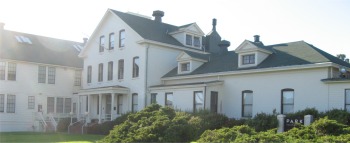
Fort Mason Old Hospital
|
Fort Mason, also known as the San Francisco Port of Embarkation, was initially built as a coastal defence site before becoming a military port facility. At its heart, up on a bluff, was an important building. It was originally an army hospital in 1902, built to accommodate twelve patients. By 1906, most of Fort Mason's sick soldiers were sent to the Presidio's larger facility and much of the hospital here was used for temporary barracks, storage, and other non-critical functions. The building's future was set, the old hospital became the new shipping centre's headquarters. The building went on to become the US Army's headquarters for troop and supply transport to the Pacific. It was now the headquarters for the Golden Gate National Recreation Area.
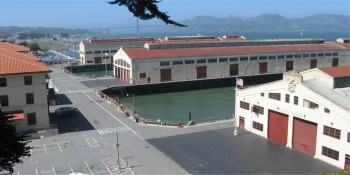
Fort Mason Embarkation Wharves
|
It was in 1912 that the army established a major troop and cargo depot along Fort Mason's shoreline with three wharves and four concrete warehouses on landfill. During World War II, this Port of Embarkation shipped 1.5 million troops and 23 million tons of cargo to the Pacific Theatre of War. It seemed to me ironic that here was an embarkation port, and just a few miles across the bay was Angel Island, where people immigrating to San Francisco had to disembark before being accepted onto the mainland. It was a sobering thought when I asked myself, for how many of those troops, was this port their last ever point at which they stood on home ground.
Nowadays the shoreline development was part of the Golden Gate National Recreation Area and the site of several recreational and cultural facilities. Today was an open-air market day, where fresh produce and locally baked breads and pastries could be bought. The fruit and vegetable stalls provided a colourful sight.
I continued past the marina. The flat land inshore from the marina would have been mostly wilderness in the mid 19th century. A lagoon gave washerwomen a local livelihood, but by the 1880s the water was so foul with pollution that prison chain gangs were brought in to fill in the lagoon. Dairy farming on the land was the next enterprise, the cattle being fed on leftovers from the San Francisco whiskey stills. Poor hygiene soon ended this venture. Now the land was covered with expensive looking properties built on shaky foundations in an earthquake prone zone.

Palace of Fine Arts
|
After passing the marina, I made a diversion to the Palace of Fine Arts. It was in 1915 when San Francisco hosted a world fair, The Panama-Pacific International Exposition. A 635 acre tract of land between Fort Mason and the Presidio (now Marina District) was a grand imagination, proclaiming to the world that San Francisco was fully recovered from the 1906 earthquake. Exhibition-filled palaces were built on filled marshlands. Enormous replicas of Yellowstone Park and the Grand Canyon were constructed at Fort Mason. The nine-month fair celebrated the opening of the Panama Canal and coincided with the opening of the army's new shipping facility at lower Fort Mason.
The Palace of Fine Arts, the only remaining one of a few built as picturesque backdrops for the 1915 world fair, was a fake Greco-Roman ruin, originally built in wood, burlap and plaster by Bernard Maybeck. San Francisco decided to make it permanent in steel and concrete. In 1969 the former Exhibit Hall became home to the Exploratorium interactive museum, and in 1970 also became the home of the 1,000 seat Palace of Fine Arts Theatre.
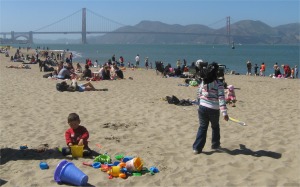
Weekend Relaxation on the Beach
|
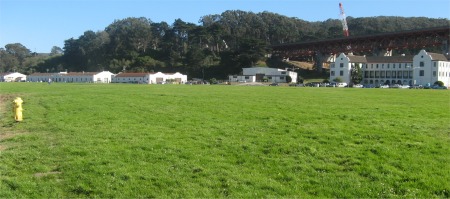
Crissy Field
|
I continued heading west past throngs of people relaxing on the sandy beach, towards Crissy Field, which had historic roots. The Yelamu were one of 50 independent Ohlone tribes related through culture and language. Ohlone peoples had lived in the Bay Area for several thousand years. The Yelamu territory included today's Crissy Field. Archeological study of remains found at Crissy Field indicates the Yelamu lived here when plants, fish and other animals were available for harvest.
The land had undergone many changes since then. It was a landing site for Spanish and Russian explorers, a venue for the Panama-Pacific International Exposition, and a pioneering US military airfield. Given its strategic location on the West Coast and its capacity to accommodate both land and sea planes, Crissy Field influenced the expansion of military air power and the rise of commercial aviation.
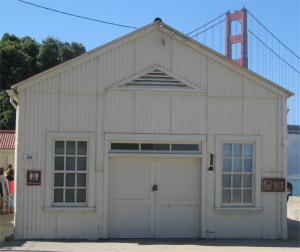
Fort Point Mine Depot
|
At the most westerly end of Crissy Field, near the Warming Hut, picnickers lolled about on the grass without a care in the world, after all it was a long weekend. Just past the Warming Hut was the Fort Point Mine Depot, created to defend the West Coast's greatest harbour from enemy attack. Here, US Army personnel assembled mines, loaded them on ships and planted them in minefields outside the Golden Gate. An enemy ship attempting to enter San Francisco Bay would have had to manoeuvre through a deadly obstacle course. Completed in 1910, the depot remained in service through World War II.
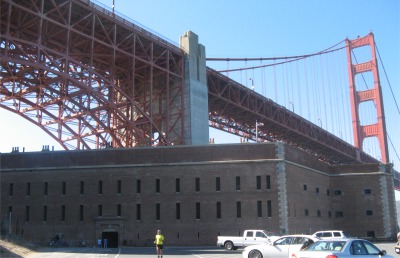
Fort Point
|
I carried on with my journey toward Fort Point. This was a Civil War era brick fortress, the last of its type ever built in the US, and an excellent example of Third System brick and mortar coastal fortification. In the 1850s, military officials declared its position at the Golden Gate as the key to the whole Pacific Coast. It survived as a monument to a bygone era.
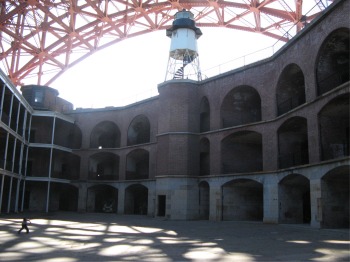
Fort Point Lighthouse
|
Built by the US Army between 1853 and 1861, it defended the San Francisco harbour against invasion by foreign powers. This fort was a classic example of early 19th century coastal fortifications.
The Civil War broke out shortly after the fort's completion. Advances in technology during the war, such as rifled artillery and iron-clad ships, made it less effective as a defence. Still, it defended the harbour another thirty years before the fort's canon were removed in the 1890s.
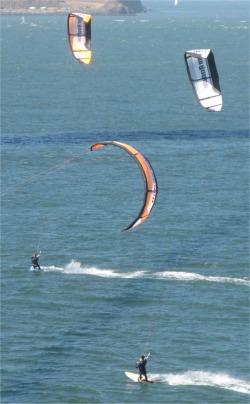
Parasurfers by the Fort
|
In the 1930s engineers used Fort Point as their headquarters when building the Golden Gate Bridge. Then, during World War II, it defended the harbour against enemy submarines. In 1970, Congress made Fort Point a National Historic Site, part of the National Park System.
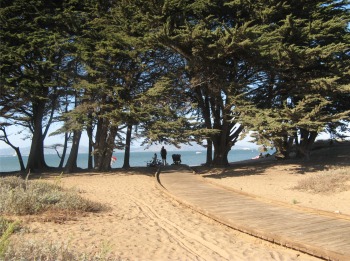
View of the Bay from Marina
|
I entered the fort and climbed up to the ramparts where I felt the full brunt of a cold wind blowing in off the Pacific. I could see from the view that this was a prime vantage point from which to defend the entrance to the bay. This was a substantial fortification with walls over 7 feet thick at the top of the construction.
Directly overhead was the Golden Great Bridge with its constant drone of traffic competing with the howl of the wind. From the fort, parasurfers could be seen zipping across the Golden Gate and performing gymnastic stunts as they somersaulted hrough the air before tacking.
I returned the same way as I came. It was a pleasant walk. I did not push myself to do sub 14 minute miles as I did earlier in my trek, I just took my time and enjoyed the stroll. It had taken me a while to wind down.
In the evening, I returned to Polk Street, and went to the first restaurant I came across, a Vietnamese restaurant. After finishing my meal and I was writing notes up in my notebook, when a chap came up with a bowl and asked me if I would mind if he joined me. I was perplexed, but at the same time curious as to the tale he could tell, so I said it would be OK. He sat down, took a chop-stick full of noodles out of his bowl, and then said his girlfriend was cheesing him off. I could tell after the first few syllables that he had had one too many. He detected a Scottish accent, which I corrected, then he asked me what football team I supported. Somewhat confused at this I said my nearest team was Ipswich Town, which he appeared to know. It turned out he was an Arsenal fan, and he went on to tell me about an Arsenal pub in the city. He decided to explain to me that that San Francisco was a very European city, at which point I concluded that he had lost the plot completely. He nipped off to check something with his other half, and returned. She was still annoyed with him. At that point I suggested he ought to stay off the booze for a while, offered my condolences for being an Arsenal fan, excused myself, wished him best of luck with his relationship, and left.
Crumbs, some people live complicated lives.










